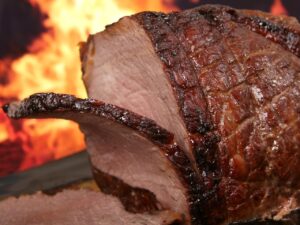Key Takeaway
| Information | Stainless Steel | Cast Iron |
|---|---|---|
| Heat Distribution | Evenly distributes heat | Uneven heat distribution |
| Maintenance | Easy to clean and maintain | Requires seasoning and upkeep |
| Durability | Resistant to rust and corrosion | Prone to rust and requires care |
| Cooking Performance | Suitable for delicate cooking | Retains heat and provides sear |
| Price | Generally more expensive | Affordable option |
| Weight | Lightweight | Heavy and sturdy |
| Versatility | Suitable for a variety of dishes | Mainly used for searing and frying |
Stainless Steel vs. Cast Iron Griddles: A Battle of Durability and Performance
When it comes to griddles, the choice between stainless steel and cast iron can perplex many cooking enthusiasts. Both materials have their own advantages and choosing the right one depends on individual preferences and cooking needs. In this article, we will examine the key differences between stainless steel and cast iron griddles, highlighting their respective strengths and considerations to help you make an informed decision.
Heat Distribution: Evenness vs. Searing Potential
Stainless steel griddles are known for their excellent heat distribution. They evenly distribute heat across the cooking surface, ensuring consistent cooking results. This even heat distribution makes them ideal for cooking delicate foods that require gentle heat, such as pancakes or eggs. On the other hand, cast iron griddles have a reputation for retaining heat exceptionally well and providing a superior sear. This makes them perfect for dishes that benefit from a deeply caramelized crust, like steak or burgers.
Table: Heat Distribution
| Aspects | Stainless Steel | Cast Iron |
|---|---|---|
| Heat Distribution | Evenly distributes heat | Retains heat and provides sear |
| Ideal For | Delicate cooking | Searing and caramelized crust |
Maintenance: Convenience vs. Seasoning
One of the appealing aspects of stainless steel griddles is their easy maintenance. They are non-porous and resistant to rust and corrosion, making them a breeze to clean. Simply wipe away any residue with a sponge or cloth, and they are good to go. On the other hand, cast iron griddles require seasoning to prevent rust and maintain a non-stick surface. This process involves coating the griddle with oil and baking it in the oven. While this may seem like a hassle to some, many cast iron enthusiasts enjoy the ritual and the enhanced flavor it brings to their cooking.
List: Maintenance
- Stainless steel griddles are easy to clean and maintain.
- Cast iron griddles require seasoning to prevent rust and maintain a non-stick surface.
Durability: Resistance vs. Care
Stainless steel griddles are highly durable and resistant to rust and corrosion. They can withstand the rigors of regular use and are less prone to damage. On the other hand, cast iron griddles, though sturdy, are susceptible to rust if not properly cared for. Regular seasoning and proper storage are essential to ensure their longevity.
Table: Durability
| Aspects | Stainless Steel | Cast Iron |
|---|---|---|
| Durability | Resistant to rust and corrosion | Prone to rust and requires proper care |
| Longevity | Long-lasting | Requires regular maintenance and upkeep |
Cooking Performance: Versatility vs. Specialization
Stainless steel griddles offer versatility in the kitchen. They are suitable for a wide range of dishes, from sautéed vegetables to delicate fish fillets. The even heat distribution and non-reactive nature of stainless steel make it a popular choice among chefs seeking consistent results. Cast iron griddles, on the other hand, excel in searing and frying. They retain heat exceptionally well and deliver the superior browning and caramelization desired in certain dishes.
List: Cooking Performance
- Stainless steel griddles offer versatility and can be used for various cooking styles.
- Cast iron griddles are especially suitable for searing and frying to achieve delicious browning and caramelization.
Price: Balancing the Budget
In terms of price, stainless steel griddles generally tend to be more expensive than cast iron ones. However, it’s important to consider the overall value and longevity of the griddle when making a purchasing decision.
While stainless steel griddles may have a higher upfront cost, their durability and low maintenance requirements can make them a worthwhile investment in the long run. Cast iron griddles, on the other hand, provide a more affordable option for those on a budget.
Weight: Lighter vs. Sturdy
If portability is a priority, stainless steel griddles are the clear winner. They are lightweight and easy to move around, making them suitable for camping trips or outdoor gatherings.
On the other hand, cast iron griddles are heavy and sturdy, which ensures stability during cooking but may limit their mobility.
Table: Weight
| Aspects | Stainless Steel | Cast Iron |
|---|---|---|
| Weight | Lightweight | Heavy and sturdy |
| Portability | Suitable for outdoor and camping trips | Stays in place during cooking |
Conclusion
In the battle between stainless steel and cast iron griddles, both contenders bring their unique strengths to the table. Stainless steel griddles offer even heat distribution, easy maintenance, and versatility, while cast iron griddles excel in heat retention, searing, and provide a touch of nostalgia through seasoning.
Consider your cooking preferences, maintenance routine, and budget to make the best choice for your culinary adventures. Whichever griddle you choose, both will undoubtedly enhance your cooking experience and deliver delicious results.
